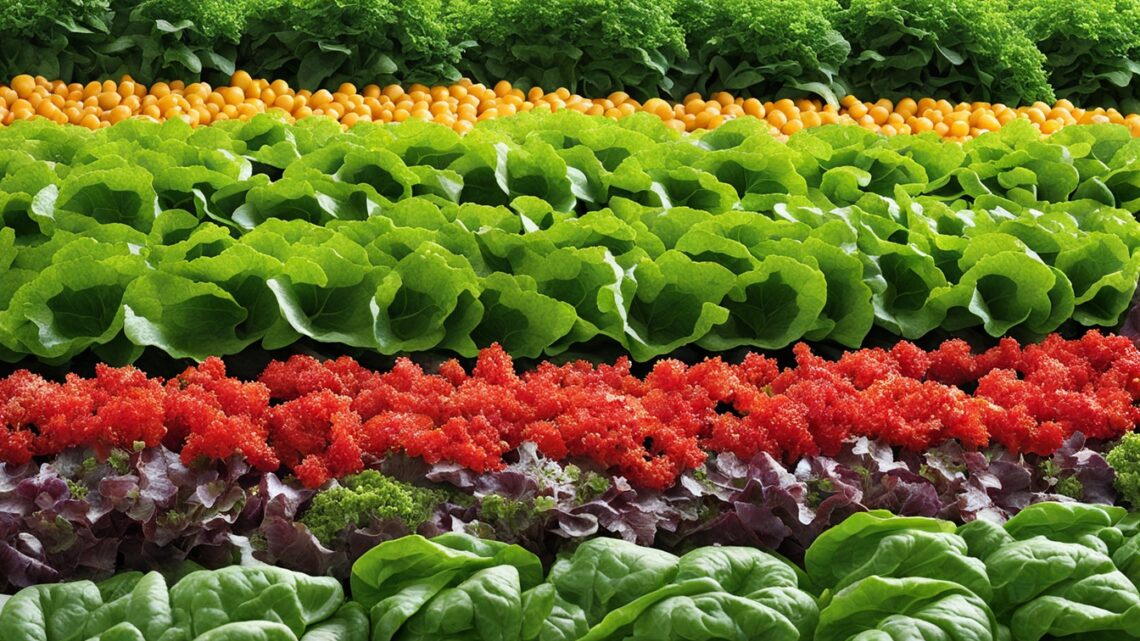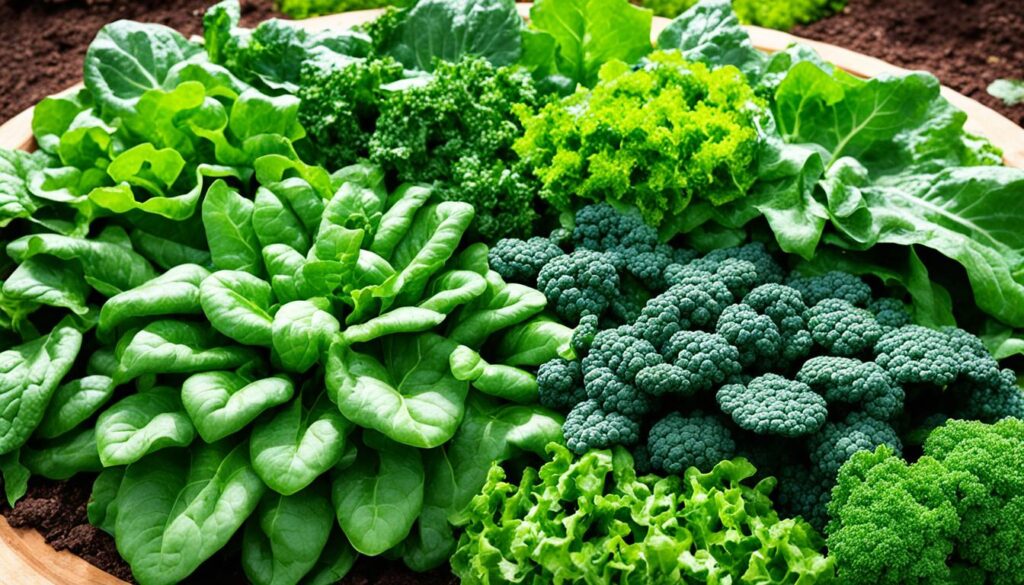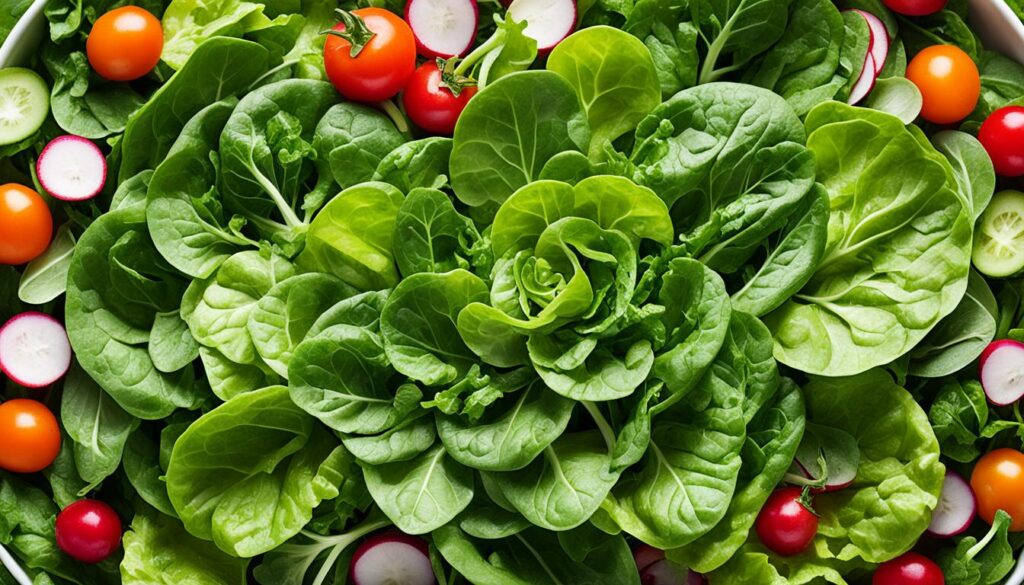
Are you tired of boring salads that leave you feeling unsatisfied? You’re not alone. In fact, nearly 80% of us aren’t getting enough fruits and vegetables in our daily diets. But what if we told you that with the right mix of nutrient-dense salad greens, you can create a delicious, filling, and satisfying salad that you’ll actually crave?
Get ready to discover the power of salad greens. Learn how to build a salad that will have you coming back for more.
Embrace the Power of Dark, Leafy Greens
Dark, leafy greens are key to a tasty and healthy salad. They’re more than just iceberg lettuce. Arugula, spinach, and kale are full of vitamins, minerals, and antioxidants. These can make your meals better.
Arugula, Spinach, and Kale: Nutrient-Rich Powerhouses
Dark leafy greens are not only good-looking but also full of health benefits. They have vitamins A, C, E, and K, plus minerals like calcium, magnesium, and potassium. Eating these bitter greens can help your brain work better and fight age-related brain decline.
These greens are also great for your gut. They help with digestion, prevent constipation, and keep things regular. They have anti-inflammatory properties too. This comes from their antioxidants and phytochemicals, which can lower inflammation in your body.
| Nutrient | Spinach (1 cup) | Kale (1 cup) | Arugula (1 cup) |
|---|---|---|---|
| Vitamin A | 300% RDI | 206% RDI | 106% RDI |
| Vitamin K | 1000% RDI | 684% RDI | 105% RDI |
| Folate | 15% RDI | 6% RDI | 4% RDI |
| Calcium | 9% RDI | 9% RDI | 3% RDI |
Adding different kinds of dark leafy greens to your salads is good for your health. They support your overall well-being. Let their power make your taste buds and body happy.

Build a Nutritious and Flavor-Packed Salad
Making a great salad is about using a mix of salad ingredients. Choose from crisp fruits and vegetables and exciting textures and flavors. This mix makes a salad that’s good for you and tastes great.
Begin with leafy greens like romaine, Boston, or Bibb lettuce. Add bold flavors with arugula or baby kale. These greens make a crunchy base for your salad.
Then, add colorful produce like diced bell peppers, juicy tomatoes, and crisp cucumber. Shredded carrots and seasonal fruits like oranges or grapes add more fun. This mix of textures and flavors makes your salad exciting.
Add wholesome things like toasted nuts, crunchy seeds, or grains like quinoa. These add nutrients and a nice crunch.
Include a lean protein source like grilled chicken, marinated tofu, or chickpeas. This turns your salad into a full meal that keeps you full.
Finish with a tasty vinaigrette or a creamy dressing. A good dressing brings all the flavors together.
By choosing the right salad ingredients, fruits and vegetables, and textures and flavors, you make a salad that looks good and tastes amazing. Let your creativity shine in every bite.

Salad Greens: A Nutrient-Dense Addition to Your Meals
Building a nutritious salad starts with choosing fresh, nutrient-dense salad greens. These include crisp lettuce and vibrant dark leafy greens. They add flavor and important vitamins, minerals, and fiber to your meals.
Romaine lettuce is full of nutrients. It gives you 30% of vitamin A and almost three-quarters of vitamin K in 2 cups. Kale is also great, with 19% of vitamin A, 23% of vitamin C, and more than 4 times the vitamin K you need in a cup of cooked greens.
Spinach is another top choice, with 16% of vitamin A and all the vitamin K you need in 1 cup. Beet greens are often missed but are packed with nutrients. They give you 13% of vitamin A and all the vitamin K you need in a cup of raw greens.

There are many salad options, each with its own taste and nutrients. From arugula’s peppery flavor to baby bok choy’s sweetness, using different salad greens makes meals balanced and nutrient-dense. This brings the benefits of salad to your meals.
Choose Lean Protein Sources for Satiety
Adding the right protein to your salads can help you feel full and satisfied. Protein is key for building and keeping muscles strong. But not all protein foods are the same. Choose lean protein options that are low in fat and calories.
Marinated Tofu, Beans, and Lean Meats: Protein-Packed Options
Try adding 3 to 4 ounces of lean protein like marinated tofu, black beans, lentils, crisped chickpeas, chicken, or steak to your salads. These foods are full of protein and won’t make you feel heavy. For extra flavor, add Italian tuna in olive oil to your salad.
| Protein Source | Protein Content (per 3-4 oz) | Calories | Fat |
|---|---|---|---|
| Marinated Tofu | 14-18g | 120-160 | 6-10g |
| Black Beans | 12-15g | 120-150 | 0-2g |
| Lentils | 15-18g | 140-180 | 0-2g |
| Crisped Chickpeas | 10-14g | 160-200 | 4-8g |
| Chicken Breast | 20-25g | 130-160 | 3-5g |
| Steak | 22-28g | 180-220 | 8-12g |
| Italian Tuna in Olive Oil | 18-22g | 160-200 | 6-10g |
By adding lean protein sources, your salads will be tasty and filling. They’ll keep you full and give you energy all day.
Embrace Healthy Fats for Nutrient Absorption
Fats are key in a balanced salad. They help absorb vitamins A, D, E, and K from the veggies. Adding 2 teaspoons (about 10 grams) of healthy fats like olive oil, avocado, or nuts makes your salad more filling and nutritious.
Studies show that full-fat salad dressings have «good fats» that lower «bad» LDL cholesterol. Full-fat dairy is also linked to less body weight in many cases. Adding healthy fats to your salad helps make your diet balanced and sustainable.
Getting enough nutrient absorption from your salad is key. Healthy fats are a big part of making your salad nutritious and filling. Enjoy a meal that boosts your health and wellbeing.



